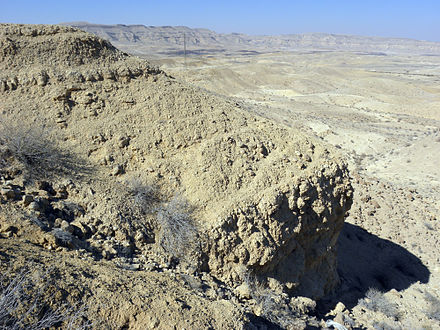Callovian
| Callovian | |||||||||
|---|---|---|---|---|---|---|---|---|---|
| Chronology | |||||||||
| |||||||||
| Etymology | |||||||||
| Name formality | Formal | ||||||||
| Usage information | |||||||||
| Celestial body | Earth | ||||||||
| Regional usage | Global (ICS) | ||||||||
| Time scale(s) used | ICS Time Scale | ||||||||
| Definition | |||||||||
| Chronological unit | Age | ||||||||
| Stratigraphic unit | Stage | ||||||||
| Time span formality | Formal | ||||||||
| Lower boundary definition | FAD of the Ammonite genus Kepplerites | ||||||||
| Lower boundary GSSP candidate section(s) | |||||||||
| Upper boundary definition | FAD of ammonite species Brightia thuouxensis | ||||||||
| Upper boundary GSSP candidate section(s) |
| ||||||||
In the geologic timescale, the Callovian is an age and stage in the Middle Jurassic, lasting between 165.3 ± 1.1 Ma (million years ago) and 161.5 ± 1.0 Ma.[2] It is the last stage of the Middle Jurassic, following the Bathonian and preceding the Oxfordian.[3]
Stratigraphic definitions
The Callovian Stage was first described by French palaeontologist Alcide d'Orbigny in 1852. Its name derives from the latinized name for Kellaways Bridge, a small hamlet 3 km north-east of Chippenham, Wiltshire, England.
The base of the Callovian is defined as the place in the stratigraphic column where the ammonite genus Kepplerites first appears, which is the base of the biozone of Macrocephalites herveyi. A global reference profile (a GSSP) for the base had in 2009 not yet been assigned.
The top of the Callovian (the base of the Oxfordian) is at the first appearance of ammonite species Brightia thuouxensis.
Subdivision

The Callovian is often subdivided into three substages (or subages): Lower/Early, Middle and Upper/Late Callovian. In the Tethys domain, the Callovian encompasses six ammonite biozones:
- zone of Quenstedtoceras lamberti
- zone of Peltoceras athleta
- zone of Erymnoceras coronatum
- zone of Reineckeia anceps
- zone of Macrocephalites gracilis
- zone of Bullatimorphites bullatus
Palaeogeography

During the Callovian, Europe was an archipelago of a dozen or so large islands. Between them were extensive areas of continental shelf. Consequently, there are shallow marine Callovian deposits in Russia and from Belarus, through Poland and Germany, into France and eastern Spain and much of England. Around the former island coasts are frequently, land-derived sediments. These are to be found, for example, in western Scotland.[5]
The Louann Salt and the southern Campeche Salt of the Gulf of Mexico are thought to have formed by an embayment of the Pacific Ocean across modern-day Mexico.[6]
References
- ^ "International Chronostratigraphic Chart" (PDF). International Commission on Stratigraphy.
- ^ "International Commission on Stratigraphy". stratigraphy.org. Retrieved 2023-02-20.
- ^ See for a detailed geologic timescale Gradstein et al. (2004)
- ^ "BGS Lexicon of Named Rock Units - Result Details".
- ^ Elmi & Babin fig.55.
- ^ Salvador, Amos (1987). "Late Triassic‐Jurassic Paleogeography and Origin of Gulf of Mexico Basin" (PDF). AAPG Bulletin. 71 (4): 419‐451. Retrieved 2011-03-09.[permanent dead link]
Literature
- Elmi, S. & Babin, C.; 2002: Histoire de la Terre, Dunod, Paris (2nd ed.), ISBN 2-10-006631-5. (in French)
- Gradstein, F.M.; Ogg, J.G. & Smith, A.G.; 2004: A Geologic Time Scale 2004, Cambridge University Press.
- d'Orbigny, A.C.V.M.D.; 1842: Paléontologie française. 1. Terrains oolitiques ou jurassiques. 642 p, Bertrand, Paris. (in French)
External links
- GeoWhen Database - Callovian
- Jurassic-Cretaceous timescale, at the website of the subcommission for stratigraphic information of the ICS
- Stratigraphic chart of the Upper Jurassic, at the website of Norges Network of offshore records of geology and stratigraphy
- Howe, John Allen (1911). . In Chisholm, Hugh (ed.). Encyclopædia Britannica. Vol. 5 (11th ed.). Cambridge University Press. pp. 58–59. This contains a detailed description of the British and European strata as understood at the time.